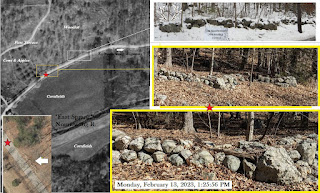“Farming” is a term that needs qualification, here on the Ceremonial Stone Landscape of the Eastern Gate of Turtle Island. When someone says that "Native American “Stone Walls” (Qusukqaniyutôkansh) are found on types of land unsuitable for farming,” whose idea of “farming” do we mean? European style farming or the domesticated landscape of Fire managed Mast Forest Gardens, thermally pruned Blueberry Gardens, Cranberry and other Wetland Gardens, as well as other fire dependent Gardens?
All those references
to Indigenous burning of the landscape that I’ve seen or heard never mention
how the fires were kept under control. Those rows of stones, low and high, all
seem to have the potential to perform as pretty good fuel breaks. Add in stone
bordered streams and roads (Indian Paths), and there’s an extra band of
protection, an extra bit of fire insurance so to speak.
In Nonnewaug, the stones still touch the edges of the floodplains that were the agricultural lands of the Pootatuck, the “furthest away fish weir” in the last floodplain in a chain of floodplains that start where the Pomperaug River empties into the Housatonic River, at the falls, at the contact era Village known as Pootatuck. After the First Puritan War (Pequot War), European (English) settler colonists from the “New London” area became interested in the acquisition of all these former farmlands. By 1673, a group of English from Stratford by way of New London, arrived in the area, putting in crops in long established cornfields, "quite to Nonnewaug Falls," where there was a late woodland village that became a contact era village, up until about 1740, when "civilization" arrived, putting chestnut rails up over ancient Stone Snakes to become "improved" private property under colonial law...
In an area where the
rare “zigzag stone fence” is abundant, there are no messy remnants of stones
tossed against wooden rails that have rotted away, but carefully made zigzag
rows of stones. Here and there, on the field side of a zigzag row of stones,
the interior angle will sometimes show tossed or dumped field clearing stones.
One just needs to pass by at just the right time, under just the right
conditions to see a Zigzag Row of Stones become an unmistakable Serpent Effigy…

.jpg)





No comments:
Post a Comment